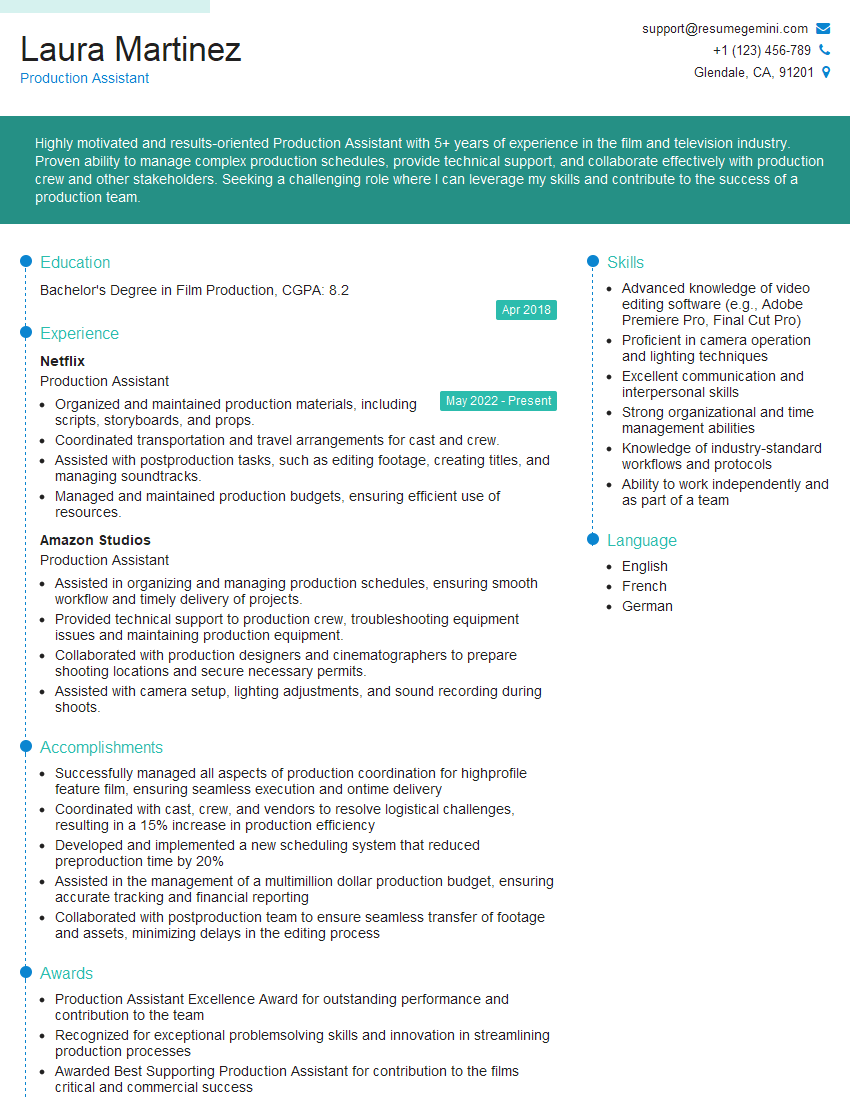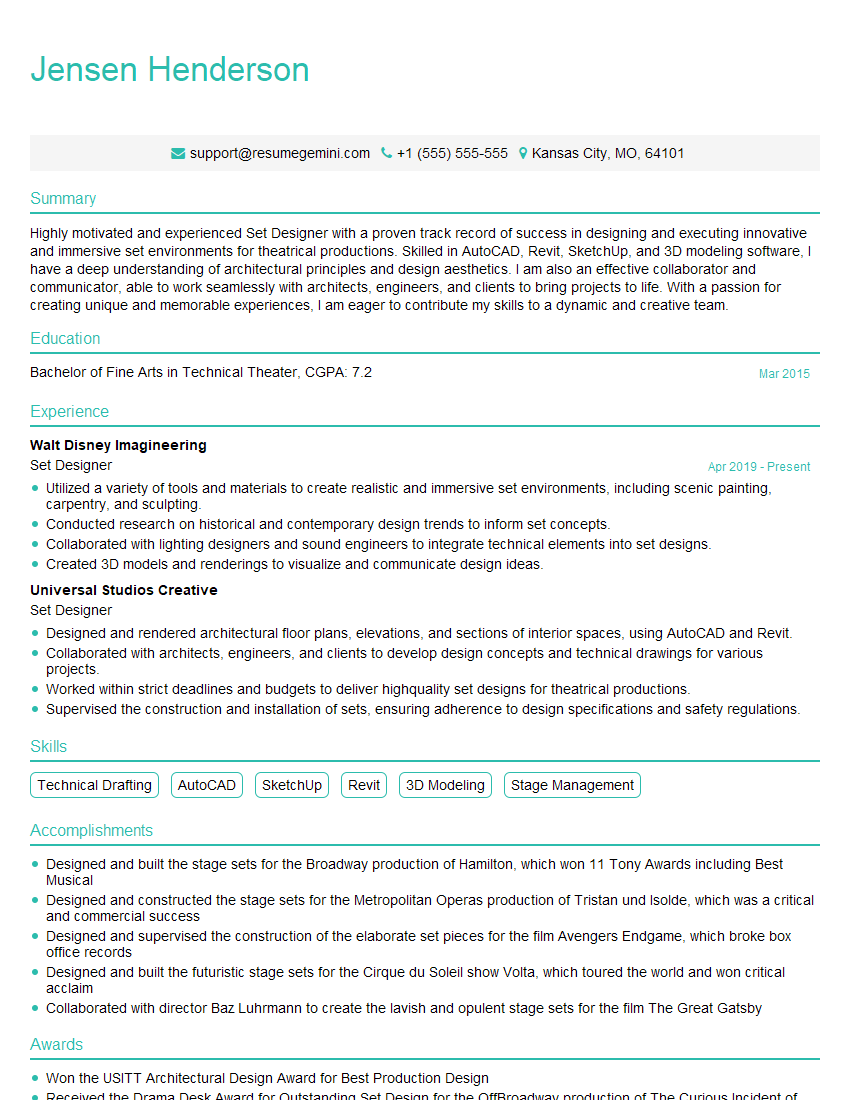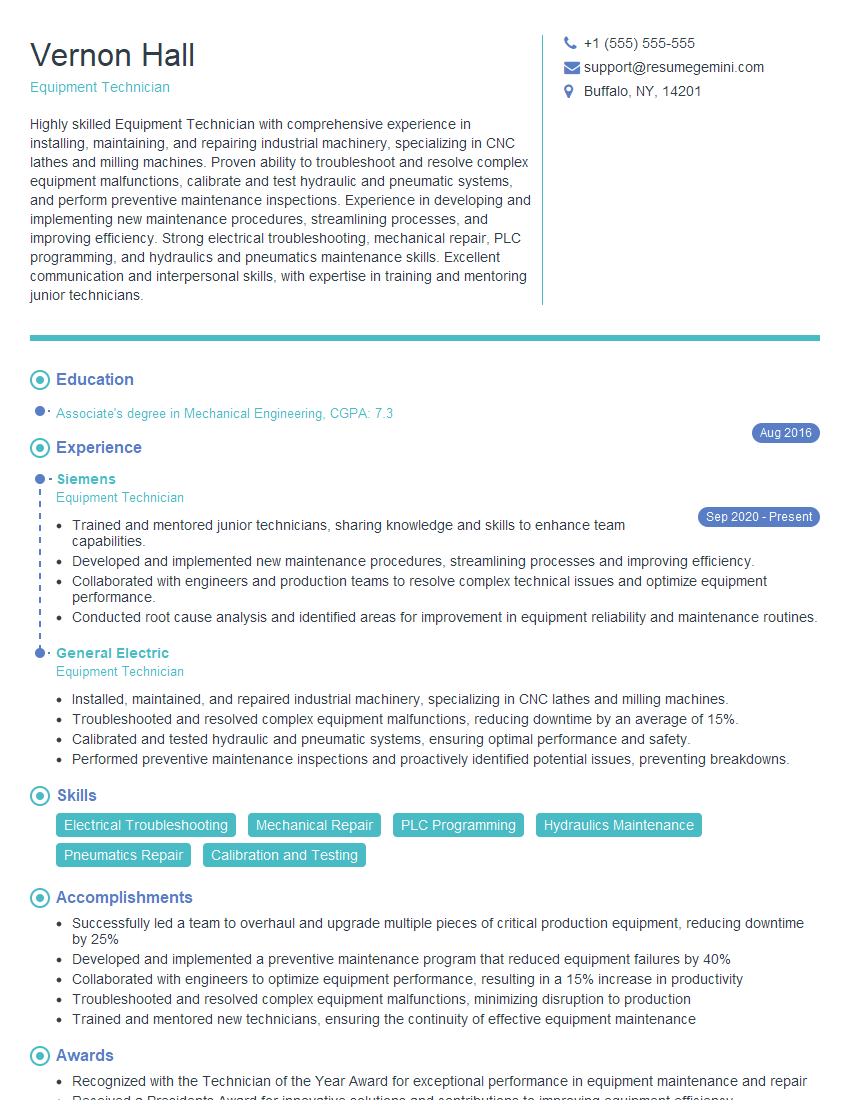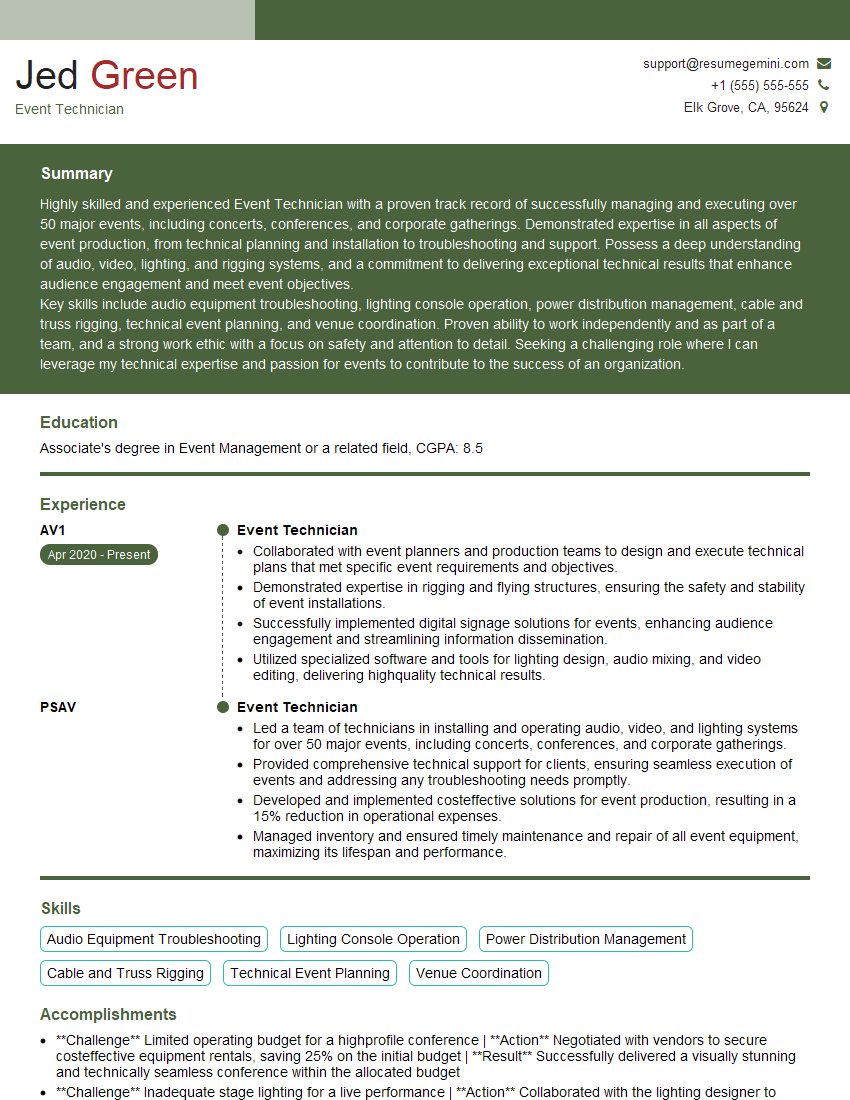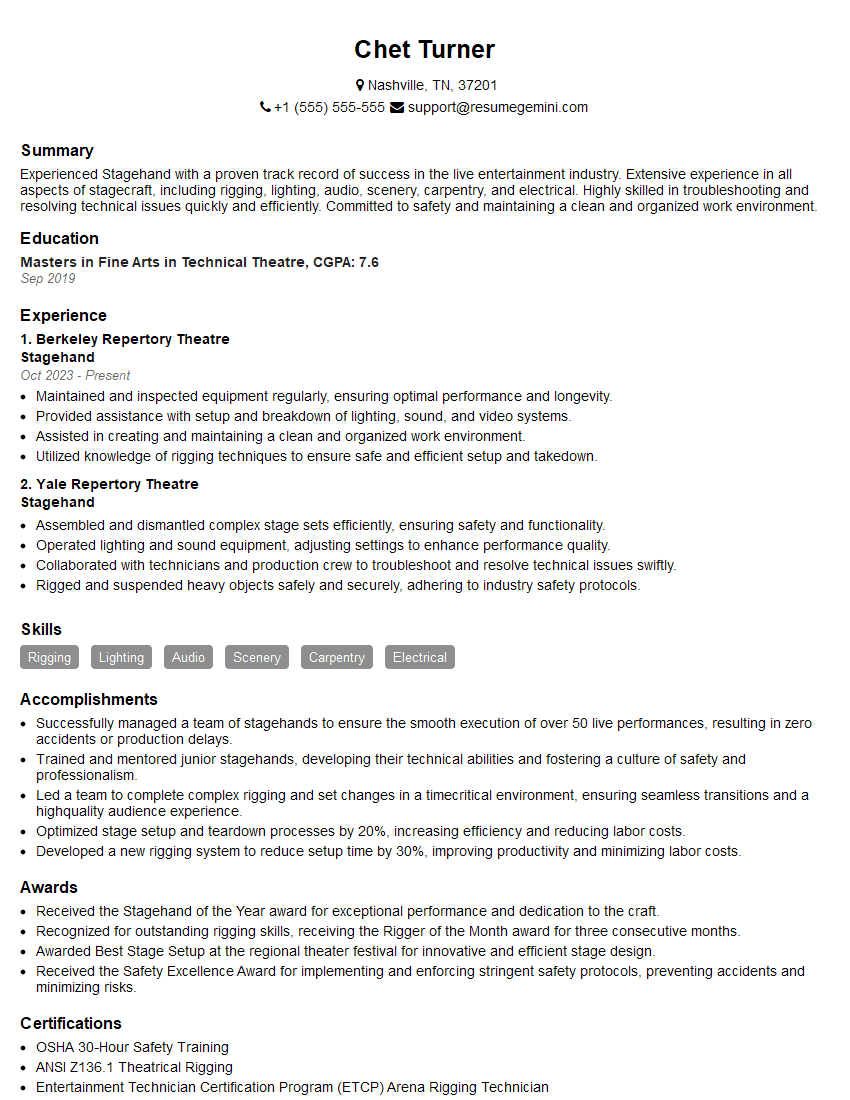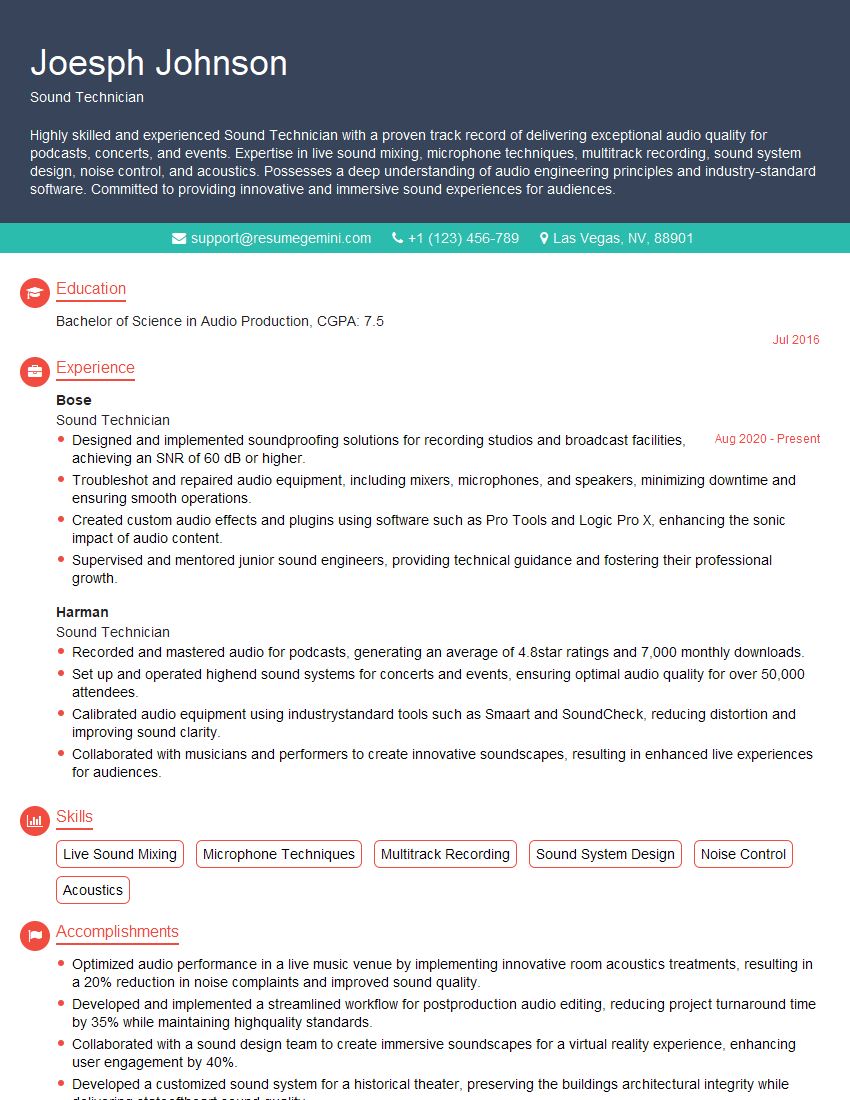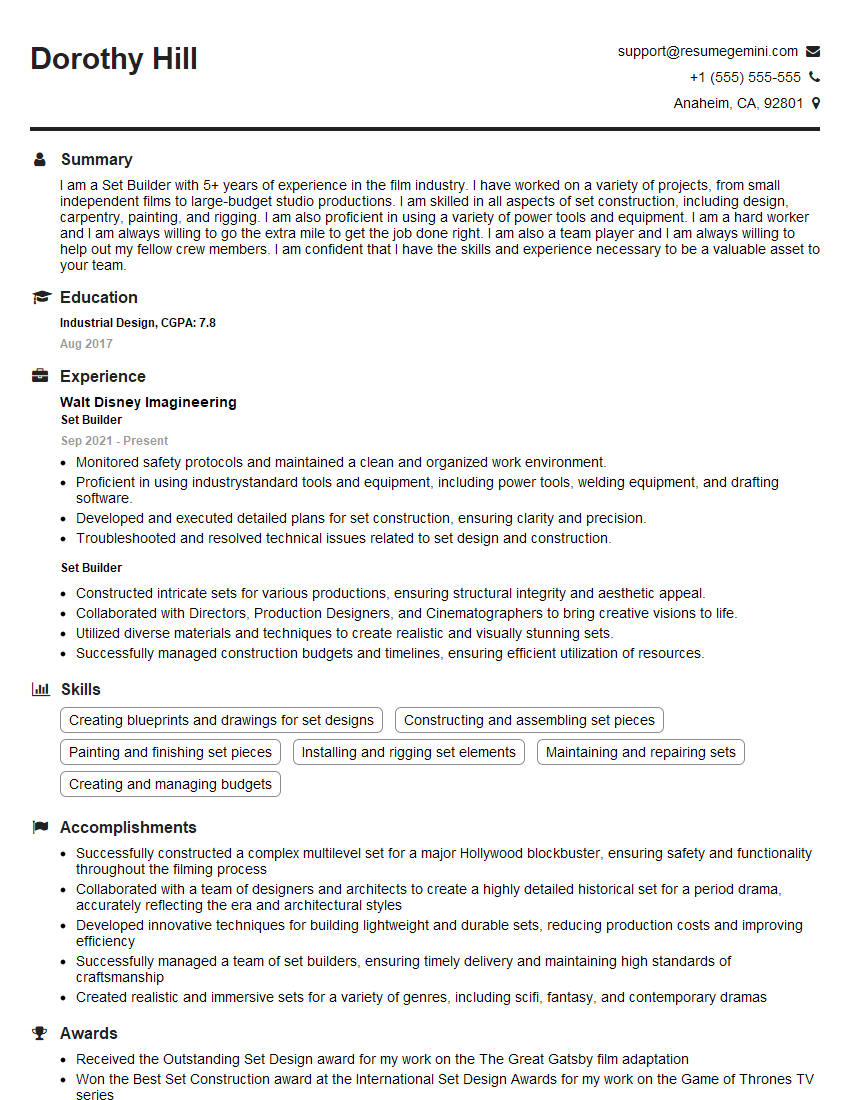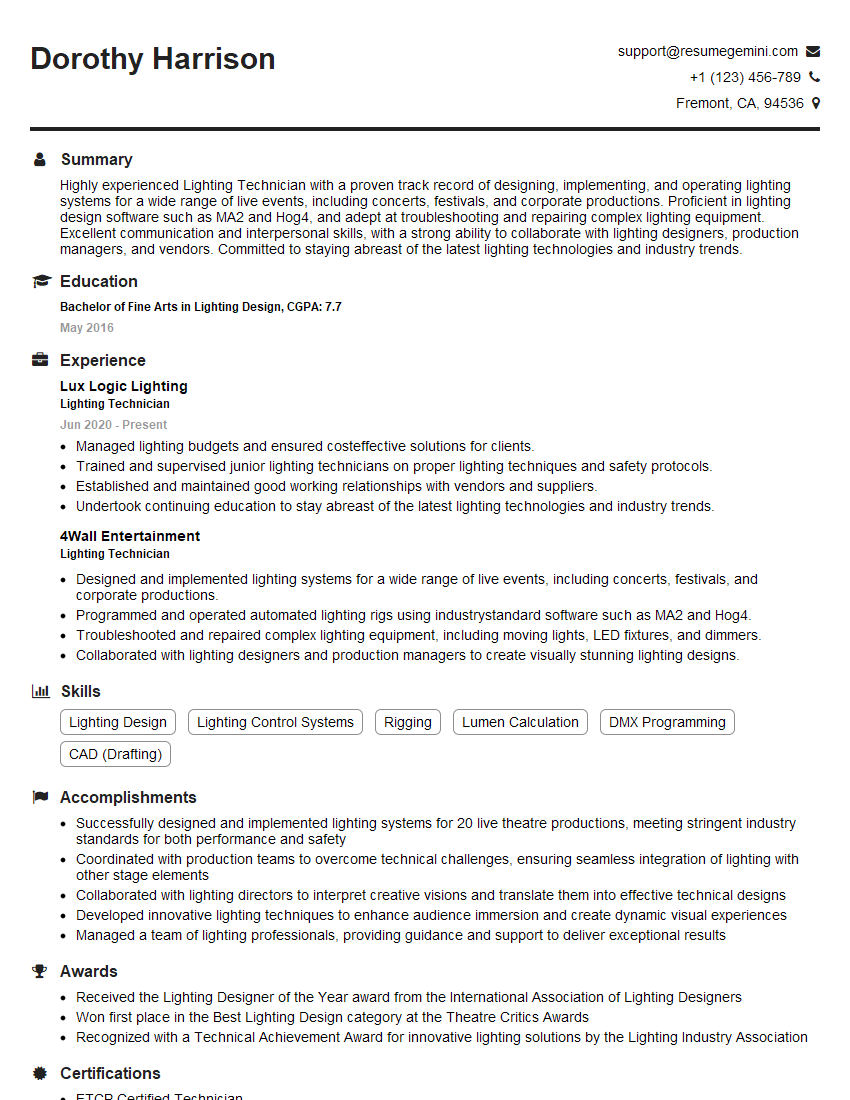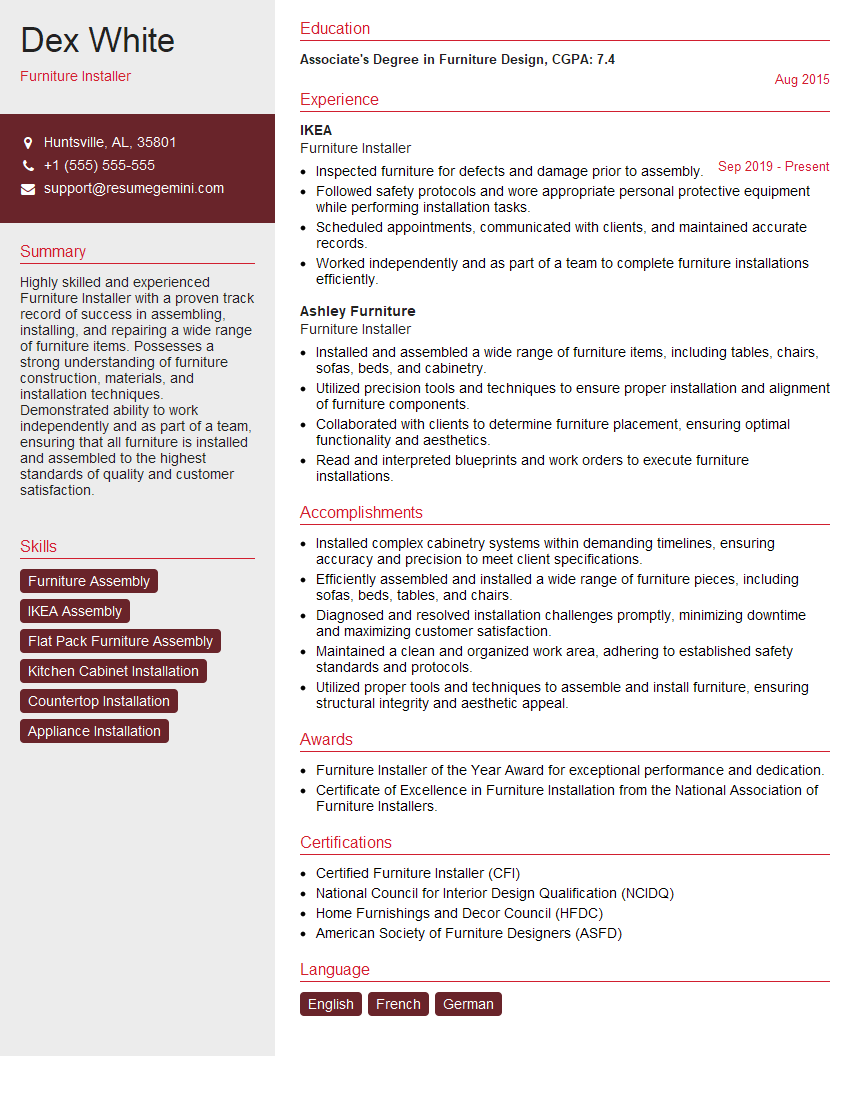Warning: search_filter(): Argument #2 ($wp_query) must be passed by reference, value given in /home/u951807797/domains/techskills.interviewgemini.com/public_html/wp-includes/class-wp-hook.php on line 324
Preparation is the key to success in any interview. In this post, we’ll explore crucial Setup and Breakdown interview questions and equip you with strategies to craft impactful answers. Whether you’re a beginner or a pro, these tips will elevate your preparation.
Questions Asked in Setup and Breakdown Interview
Q 1. Describe your experience with efficient setup and breakdown procedures.
Efficient setup and breakdown hinge on meticulous planning and a streamlined workflow. My approach involves creating detailed checklists, assigning specific roles and responsibilities to team members, and utilizing time-saving techniques. For instance, during a recent large-scale conference, we pre-assembled sections of the exhibition booths off-site, significantly reducing on-site setup time. We also color-coded cables and equipment to ensure quick identification and connection. This preemptive approach minimizes errors and ensures a smooth, rapid setup and equally efficient breakdown.
I believe in leveraging technology where possible; we use software to manage inventory and track equipment location, reducing search time and the risk of misplaced items. This system is particularly helpful for large events with numerous components. Post-event, the software generates reports which help us analyze efficiency and identify areas for improvement in future setups.
Q 2. How do you prioritize tasks during a time-sensitive setup?
Prioritization during time-sensitive setups requires a clear understanding of dependencies and critical path analysis. I use a combination of techniques including the MoSCoW method (Must have, Should have, Could have, Won’t have) to categorize tasks based on their importance. ‘Must-have’ tasks, such as essential power and network connections, always take precedence. I also employ a visual task management system, often a Kanban board, to track progress and quickly identify any bottlenecks or delays. This allows for real-time adjustments to the schedule and ensures that the most critical aspects are addressed first.
For example, during a product launch where the product display was crucial, we prioritized the setup of that display before tackling less critical elements like decorative lighting. This ensured the event’s core objective was met even if minor elements were slightly delayed.
Q 3. What safety precautions do you consistently follow during setup and breakdown?
Safety is paramount. My consistent safety protocols include a thorough risk assessment before any setup begins. This identifies potential hazards, like trip hazards from cables or unstable structures. We always utilize appropriate personal protective equipment (PPE), including safety glasses, gloves, and steel-toe boots, as necessary. Proper lifting techniques are emphasized to prevent injuries, and team members receive regular training on the safe operation of all equipment, including forklifts and other power tools. Clear communication and designated safety officers are essential in coordinating efforts and ensuring adherence to safety regulations.
For instance, before every setup, we conduct a ‘toolbox talk’ to review safety procedures and address any immediate concerns. This fosters a culture of safety and prevents accidents.
Q 4. Explain your method for managing inventory during setup and breakdown.
Inventory management is crucial for efficient setup and breakdown. I use a combination of physical and digital methods. A detailed inventory list, ideally barcoded, is maintained for every event, allowing for precise tracking of items. We use a dedicated inventory management software that allows us to check items in and out, noting their location during the setup. This minimizes loss or damage. After the event, a thorough reconciliation is performed, comparing the post-event inventory with the pre-event list, identifying any discrepancies or missing items immediately.
During breakdown, we meticulously return all items to their designated storage areas, following the same software-driven system, thus preparing for the next event’s setup efficiently.
Q 5. How do you handle unexpected problems or delays during setup?
Unexpected problems are inevitable. My approach emphasizes proactive problem-solving. First, we assess the problem’s severity and impact on the overall schedule. Minor issues, such as a small technical glitch, can be addressed by the team on the spot. For more significant issues – like a damaged piece of equipment – we have established communication protocols to notify relevant stakeholders immediately, find alternative solutions or replacements, and re-prioritize tasks as necessary. Flexibility and adaptability are key. I often utilize contingency plans to minimize disruption.
For instance, during one event, a crucial projector malfunctioned. We had a backup projector ready, and our pre-planned communication ensured the tech team was immediately alerted and quickly replaced the faulty projector with minimal downtime.
Q 6. Describe your experience with different types of event setups (e.g., conferences, trade shows).
My experience spans various event types, including conferences, trade shows, corporate events, and smaller-scale gatherings. Each setup requires a unique approach. Conferences usually involve complex booth arrangements, requiring detailed floor plans and coordination with multiple exhibitors. Trade shows often have stricter regulations and timelines, demanding precise planning and a highly organized team. Corporate events can range from formal galas to informal team-building activities, each with distinct requirements. My adaptability allows me to tailor my setup strategies to each event’s specific needs and constraints.
I understand the different logistical demands of each type; for example, a trade show requires efficient booth construction alongside compliance with venue-specific guidelines, whereas a conference necessitates advanced coordination with presenters and technical support teams.
Q 7. What tools and equipment are you proficient in using for setup and breakdown?
I’m proficient in using a wide range of tools and equipment, including various hand tools (hammers, screwdrivers, wrenches), power tools (drills, saws), lifting equipment (forklifts, pallet jacks), audio-visual equipment (projectors, sound systems), and rigging equipment (chains, hoists). My expertise extends to the safe and effective use of these tools within different event settings. I am also comfortable using various software applications for inventory management, scheduling, and communication. Continuing professional development ensures I stay updated on the latest technology and safety standards within the industry.
Proficiency includes not only the practical operation but also the maintenance and troubleshooting of these tools, ensuring the setup runs smoothly and safely.
Q 8. How do you ensure the proper storage and transportation of equipment after breakdown?
Proper storage and transportation of equipment after breakdown are crucial for maintaining its lifespan and ensuring readiness for future events. My process involves several key steps:
- Inventory and Categorization: Before we even begin dismantling, we create a detailed inventory list, often using a digital system or checklist, noting the condition of each item. We then categorize equipment by type (e.g., audio, lighting, staging) and fragility.
- Cleaning and Protection: Each piece of equipment is thoroughly cleaned and inspected for any damage. Fragile items are carefully wrapped in protective materials like bubble wrap or padded cases. Cables are neatly bundled and labeled to prevent tangling.
- Secure Packaging: We utilize appropriate cases, crates, and protective coverings based on the equipment’s sensitivity to impacts and environmental conditions. Heavier items are secured to prevent shifting during transportation.
- Organized Loading and Transportation: Loading is done strategically, placing heavier items at the bottom and securing them to prevent damage. Transportation is planned to minimize jostling. We often use climate-controlled vehicles for sensitive electronics.
- Documentation: Finally, detailed documentation, including any damage notes and a final inventory check, is completed and kept for record-keeping and insurance purposes. This ensures accountability and simplifies setup for future events.
For example, during a recent large outdoor concert, we meticulously packed our lighting equipment, ensuring each fixture was individually padded and placed in its designated case. This prevented any damage during transit, guaranteeing a smooth setup for the next event.
Q 9. What is your experience with different types of venue layouts and their impact on setup?
Experience with diverse venue layouts is critical in setup and breakdown. Different venues present unique challenges and opportunities. I’ve worked in:
- Traditional Theaters: These often involve complex rigging systems and specific stage dimensions. Understanding the fly system, grid layout, and stage weight restrictions is crucial.
- Convention Centers: These spaces are often vast and require careful planning for cable management and efficient equipment placement to prevent tripping hazards.
- Outdoor Venues: These present weather-related challenges and often involve more extensive ground preparation and security considerations. I’ve had to adjust for uneven terrain, wind conditions, and potential power outages.
- Small Event Spaces: This demands creative solutions for maximizing space and often requires flexibility in equipment placement due to space limitations.
The impact on setup is significant. For instance, a small, oddly-shaped room requires creative solutions to fit the stage and seating arrangements. A large convention hall might mean greater distances for cable runs and potentially more manpower to set up and break down efficiently.
Q 10. Explain your process for verifying setup accuracy and completeness.
Verifying setup accuracy and completeness is a systematic process aimed at preventing issues during the event. My approach involves:
- Pre-Setup Checklist: A detailed checklist is created before the setup begins, itemizing every piece of equipment and its placement. This is often shared digitally amongst the team.
- Visual Inspection: A thorough visual inspection is performed to ensure that all equipment is in place according to the checklist and that no obvious wiring or structural issues exist. We use the checklist to check off items as they are placed and tested.
- Functional Testing: Each system – audio, lighting, video, etc. – is fully tested to ensure everything is working correctly and interacting as expected. This often involves a brief soundcheck and lighting cue run-through.
- Safety Check: A final safety check is performed to ensure no hazards exist, such as exposed wires, tripping hazards, or unstable structures. This might involve a thorough walk-through with multiple team members.
- Client Sign-off (if applicable): In many cases, a client sign-off confirms the setup meets their requirements and expectations. This is often documented with photographs and a final walkthrough.
For example, before a recent corporate presentation, we meticulously checked every lighting fixture, ensuring they were properly aimed and dimmed to the correct levels before the event commenced, avoiding any issues during the live presentation.
Q 11. How do you maintain a clean and organized workspace during and after setup and breakdown?
Maintaining a clean and organized workspace is essential for efficiency and safety. My strategies include:
- Designated Areas: We establish designated areas for different types of equipment and trash. This minimizes clutter and facilitates quick access to specific items.
- Cable Management: Cables are carefully managed using cable ties, raceways, and other organization tools. This prevents tangles, tripping hazards, and enhances the overall aesthetic.
- Regular Cleaning: We regularly clean up debris and spills throughout the setup and breakdown process. This maintains a safe and professional environment.
- Waste Disposal: Proper disposal of waste materials, following all relevant environmental regulations, is crucial. This might include recycling efforts and safe disposal of hazardous materials.
- Post-Breakdown Clean-up: After the breakdown, a thorough clean-up ensures that the venue is returned to its original condition. This includes removing all trash, cables, and equipment.
Think of it like a surgeon’s operating room – precision and cleanliness are paramount for a smooth and successful procedure (in this case, an event).
Q 12. How do you communicate effectively with other team members during setup and breakdown?
Effective communication is crucial for a seamless setup and breakdown. I use several techniques:
- Pre-Event Briefing: Before each event, a detailed briefing outlines the plan, roles, responsibilities, and any potential challenges. This ensures everyone is on the same page.
- Clear and Concise Instructions: I use clear and concise language during the setup and breakdown process. I ensure that all instructions are easily understood by everyone on the team.
- Two-Way Communication: I actively encourage two-way communication, allowing team members to ask questions and provide feedback. This helps to identify and resolve issues early on.
- Non-Verbal Cues: I use non-verbal cues, such as pointing and gesturing, to enhance understanding and efficiency, especially in noisy environments.
- Post-Event Debrief: After each event, a debriefing session allows the team to discuss what went well, what could be improved, and any lessons learned. This continuous improvement cycle helps refine our processes.
Imagine building a complex LEGO structure. Clear instructions and open communication are key to creating a masterpiece.
Q 13. Describe your experience with working under pressure and meeting deadlines.
Working under pressure and meeting deadlines is a routine part of the job. I’ve consistently demonstrated the ability to manage tight timelines and unexpected challenges. My approach involves:
- Prioritization: I prioritize tasks based on urgency and impact, focusing on critical elements first. This ensures that the most important aspects are completed on time, even under pressure.
- Time Management: I use time management techniques, such as creating detailed schedules and breaking down large tasks into smaller, manageable steps. This allows for better progress tracking and adjustment as needed.
- Problem-Solving: I am adept at quickly identifying and resolving problems that may arise. My experience allows for rapid decision-making to minimize delays.
- Teamwork: Effective teamwork is essential in high-pressure situations. I collaborate closely with my team to ensure tasks are distributed efficiently and support each other when needed.
- Adaptability: I’m highly adaptable and can quickly adjust to changing circumstances and priorities without losing sight of the overall goal.
For example, during a recent event where the client requested last-minute changes, we quickly adjusted our schedule and worked collaboratively to implement the changes, still meeting the final deadline without compromising quality.
Q 14. How do you adapt to changes in the setup plan or requirements?
Adapting to changes in the setup plan or requirements is a crucial skill. My approach includes:
- Open Communication: Maintaining open communication with clients and team members is vital to identifying and addressing changes promptly. This ensures everyone is informed and can respond effectively.
- Flexibility: I’m flexible and willing to adjust my approach based on new information or unexpected circumstances. Rigidity is the enemy of efficiency in this field.
- Problem-Solving: I approach changes as opportunities to find creative solutions and optimize the setup. This may involve re-allocating resources, modifying the layout, or finding alternative equipment.
- Collaborative Decision-Making: I collaborate with the team to assess the impact of changes and determine the best course of action. This ensures a unified approach and avoids conflicts.
- Documentation: Any changes to the plan are thoroughly documented, ensuring clear records and minimizing confusion.
Imagine a sudden storm threatening an outdoor event – adaptability is crucial to ensure the safety of equipment and people while still (if possible) salvaging the event.
Q 15. What is your experience with managing different types of equipment (e.g., audio-visual, furniture)?
My experience spans a wide range of equipment, from intricate audio-visual setups including projectors, screens, microphones, and speakers, to various furniture arrangements like staging, seating, and tables. I’m proficient in handling delicate equipment, understanding the specific needs of each piece, whether it’s the careful placement of a high-definition projector or the sturdy setup of a heavy conference table. For example, during a recent corporate event, I successfully managed the setup of a complex AV system including multiple camera feeds, a large projection screen, and sophisticated sound mixing, all while ensuring seamless integration with the pre-arranged furniture layout.
- Audio-Visual: Proficient in setting up and troubleshooting projectors, screens, sound systems, lighting, and video conferencing equipment.
- Furniture: Experienced in arranging various types of seating (chairs, tables, etc.) for optimal space utilization and audience comfort.
- Staging: Skilled in building and dismantling stages of varying sizes, ensuring structural stability and safety.
Career Expert Tips:
- Ace those interviews! Prepare effectively by reviewing the Top 50 Most Common Interview Questions on ResumeGemini.
- Navigate your job search with confidence! Explore a wide range of Career Tips on ResumeGemini. Learn about common challenges and recommendations to overcome them.
- Craft the perfect resume! Master the Art of Resume Writing with ResumeGemini’s guide. Showcase your unique qualifications and achievements effectively.
- Don’t miss out on holiday savings! Build your dream resume with ResumeGemini’s ATS optimized templates.
Q 16. Explain your experience in using a checklist or schedule for efficient setup and breakdown.
Checklists and schedules are crucial for efficient setup and breakdown. Think of them as the roadmap to a successful event. I create detailed, time-sensitive checklists that cover every step, from initial equipment inspection to final cleanup. For instance, a checklist for a conference setup might include items like ‘Verify projector lamp hours,’ ‘Test microphone levels,’ ‘Arrange name tags,’ and ‘Confirm internet connectivity.’ I use project management software to schedule tasks, assigning responsibilities to team members and tracking progress. This ensures that every detail is accounted for and allows us to anticipate and address potential delays. The key is to create a checklist that is specific to the event and adaptable to any changes or unexpected issues.
For example, I recently managed a large-scale outdoor event. My schedule included specific time slots for equipment transport, setup, rehearsals, and breakdown, factoring in potential weather delays. The detailed checklist helped us stay on track, even when encountering unforeseen challenges like sudden rain showers, and maintain a smooth workflow.
Q 17. How do you ensure the safety of attendees or clients during setup and breakdown?
Safety is paramount. My approach to ensuring attendee and client safety involves several key strategies. First, I conduct thorough risk assessments before any setup begins. This includes identifying potential hazards like tripping hazards from cables, unstable equipment, and potential obstructions. I then implement safety measures such as proper cable management using cable trays and zip ties, clearly marking hazardous areas, and ensuring sufficient lighting. During the breakdown, I emphasize careful handling of equipment to prevent accidents and ensure a safe exit route for everyone.
For instance, during a trade show setup, I used caution tape to clearly delineate areas where heavy equipment was being moved. I also assigned team members to actively monitor areas with high foot traffic to prevent accidents. Clear communication with attendees and clients about safety guidelines is also crucial.
Q 18. Describe your understanding of load-bearing capacities and weight distribution during setup.
Understanding load-bearing capacities and weight distribution is essential for preventing structural damage and ensuring safety. This involves careful consideration of the weight of the equipment, the strength of the floor or staging, and proper weight distribution to avoid overloading any single point. Before setting up any heavy equipment, I verify the load-bearing capacity of the venue’s floor or stage. I use appropriate support structures like heavy-duty tables and staging systems, and ensure weight is evenly distributed to prevent collapses or damage. I also ensure that all equipment is secured properly to prevent accidental tipping or falling.
For example, when setting up a large projection screen, I carefully calculated the weight and ensured the supporting stand was rated for the load and properly anchored to the floor. Using this methodical approach prevents accidents and ensures the safety of all involved.
Q 19. What is your experience with using different rigging techniques for setup and breakdown?
My experience with rigging techniques includes the safe and efficient use of various systems, from basic lifting and hoisting to more complex configurations. I’m proficient in using appropriate lifting equipment like chain hoists, motorized lifts, and scaffolding, adhering strictly to safety regulations and best practices. Rigging requires a high level of precision and attention to detail, and I always prioritize safety. Before commencing any rigging, I conduct thorough inspections of all equipment and ensure proper training and certification for all involved personnel. I follow all relevant safety standards and always use appropriate safety harnesses and fall protection systems.
For example, in setting up lighting for a theatrical production, I utilized a counterweight system to safely hang and position heavy lighting fixtures, ensuring that all safety measures were in place and the system was properly balanced.
Q 20. How do you minimize downtime during setup and breakdown?
Minimizing downtime requires meticulous planning and a well-coordinated team. This involves pre-planning, efficient resource allocation, and effective problem-solving. By having all equipment and materials ready beforehand, assigning specific tasks to team members, and utilizing a detailed schedule, we can streamline the process. This approach allows for immediate response to any unexpected issues and helps avoid delays. In my experience, effective communication among the team members is key to a quick and efficient process.
For example, during a recent concert setup, we pre-assembled sections of the stage and lighting rigs offsite, saving valuable time on-site. This pre-planning and efficient teamwork resulted in a significantly shorter setup time with minimal downtime.
Q 21. Describe your experience with troubleshooting technical issues during setup.
Troubleshooting is an integral part of setup and breakdown. I approach technical issues systematically, using a combination of experience, diagnostic tools, and problem-solving skills. I start by identifying the problem, isolating the source, and systematically checking connections, power supplies, and individual components. If I encounter a problem beyond my immediate expertise, I know when to seek assistance from specialists. Keeping a detailed log of any issues and their resolutions allows me to improve efficiency in future events and prevent recurring problems. This log includes timestamps, descriptions, causes, and solutions. For example, if a projector malfunctions, I’d check the lamp, connections, and input sources before calling a technician.
During a recent event, a sudden power outage occurred shortly before the event start time. By quickly identifying the problem as a tripped breaker, I was able to swiftly restore power, limiting any downtime and ensuring the event ran smoothly.
Q 22. What is your process for documenting setup and breakdown activities?
My documentation process for setup and breakdown is meticulous and follows a standardized format for consistency and easy retrieval. I utilize a combination of methods to ensure complete and accurate records.
- Pre-event Checklist: Before any event, I create a detailed checklist outlining every piece of equipment, its location, setup instructions, and any special requirements. This checklist serves as a roadmap for the setup team.
- Setup Diagrams/Technical Drawings: For complex setups, I develop visual aids like diagrams or technical drawings. These provide a clear spatial representation of equipment placement, wiring, and cable management.
- Digital Inventory Management System: I utilize software like [mention specific software, e.g., Event Temple, Aisle Planner] for comprehensive inventory management. This system helps track equipment, its condition, and its location throughout the setup and breakdown process. This also allows for easy reporting and analysis.
- Post-event Report: After the event, I create a comprehensive report summarizing the setup and breakdown activities. This includes any challenges encountered, time taken, equipment condition, and suggestions for improvement.
- Photography/Videography (when applicable): For unique or complex setups, I might capture the process with photos or videos. This serves as an excellent visual record and aids in troubleshooting or future reference.
This multi-faceted approach ensures that the entire process is well-documented, readily accessible, and facilitates efficient planning for future events.
Q 23. How do you contribute to a positive and collaborative team environment during setup?
Contributing to a positive and collaborative team environment during setup is paramount to efficiency and success. I prioritize clear communication, proactive problem-solving, and mutual respect.
- Pre-Setup Briefing: I begin with a concise team briefing, outlining tasks, responsibilities, timelines, and potential challenges. This ensures everyone is on the same page.
- Delegation and Collaboration: I effectively delegate tasks based on individual strengths and experience, fostering a sense of ownership and responsibility. Open communication channels and teamwork are encouraged throughout the process.
- Positive Reinforcement: I acknowledge and appreciate the efforts of team members, fostering a supportive and motivating atmosphere. This includes recognizing both small victories and overcoming significant obstacles.
- Problem-Solving Approach: When challenges arise, I adopt a collaborative approach. Instead of assigning blame, I encourage open discussion and brainstorm solutions as a team. This builds trust and enhances teamwork.
- Maintaining Professionalism: I always maintain a professional and respectful demeanor, regardless of the pressure. Positive attitude and support go a long way in maintaining morale and teamwork.
By prioritizing these aspects, I ensure a smoothly functioning team that tackles challenges effectively and maintains a positive, productive environment.
Q 24. Describe your experience in working with different software for managing event setups.
I’ve had experience using several software solutions for event setup management, each with its strengths and weaknesses.
- [Software Name 1, e.g., Eventbrite]: This platform is excellent for managing event registrations and ticketing, which indirectly helps in gauging the scale of the setup required.
- [Software Name 2, e.g., Cvent]: I’ve used Cvent for more comprehensive event management, including floor planning tools that assist in visualizing the setup and tracking resource allocation.
- [Software Name 3, e.g., Google Sheets/Excel]: While not dedicated event management software, spreadsheets are invaluable for creating detailed inventory lists, tracking equipment, and managing logistics. They offer excellent flexibility and customizability.
My experience with these diverse platforms has allowed me to leverage their unique features and adapt my workflow for optimal efficiency, regardless of the specific software available for a given project. I’m also adept at learning new software quickly as needed.
Q 25. How do you ensure that all equipment is properly accounted for after breakdown?
Accurate equipment accounting after breakdown is crucial to avoid loss and ensure future event success. My process includes:
- Pre-Breakdown Checklist: A comprehensive checklist is used to verify the presence of all equipment before the breakdown begins.
- Paired Check-in/Check-out: Team members work in pairs to check items off the list, enhancing accuracy and minimizing errors. One person verifies, the other documents.
- Visual Inspection: A thorough visual inspection of each item is conducted to note any damage or wear and tear. This information is documented to inform future maintenance or replacement needs.
- Inventory Software Update: The inventory management system (e.g., Event Temple) is immediately updated to reflect the current status of each item. This provides an up-to-date record.
- Post-Breakdown Report: A final report details the condition of all returned equipment. Any missing or damaged items are clearly highlighted for immediate action.
This rigorous approach minimizes the risk of missing equipment, facilitates prompt repairs, and ensures readiness for future events.
Q 26. What is your understanding of health and safety regulations related to setup and breakdown?
My understanding of health and safety regulations is comprehensive and incorporates several key aspects:
- Risk Assessment: Before any setup, I conduct a thorough risk assessment, identifying potential hazards such as trip hazards, electrical risks, and heavy lifting. This assessment informs safety protocols.
- Safe Lifting Techniques: I ensure that all team members are trained in proper lifting techniques to prevent injuries. Heavy equipment is handled with appropriate machinery or assistance.
- Electrical Safety: All electrical equipment is regularly inspected and tested. Safe wiring practices are strictly enforced, and extension cords are used appropriately. RCD’s (residual current devices) are used where necessary.
- Fire Safety: I am familiar with fire safety procedures and ensure that fire exits are unobstructed and fire extinguishers are accessible. I follow any specific fire safety guidelines for the venue.
- Personal Protective Equipment (PPE): Appropriate PPE, such as safety gloves, eye protection, and hard hats, is provided and used when necessary.
- Emergency Procedures: I ensure that all team members are familiar with emergency procedures, including first aid and evacuation protocols.
Compliance with health and safety regulations is not just a formality; it’s a core value that prioritizes the wellbeing of the team and attendees. Adherence is non-negotiable.
Q 27. Describe a time you had to improvise during setup due to unforeseen circumstances.
During a large outdoor event, a sudden, unexpected downpour threatened to delay the setup significantly. Our planned stage backdrop, a large fabric structure, was vulnerable to water damage.
Instead of panicking, the team and I quickly assessed the situation. We improvised by using readily available tarps and securing them to the existing framework to create a temporary waterproof covering. This required quick thinking, collaboration, and efficient use of existing resources.
While it wasn’t the ideal solution, our quick action prevented significant damage to the backdrop and minimized the event delay. This situation highlighted the importance of adaptability, resourcefulness, and efficient teamwork under pressure.
Q 28. How do you measure the success of a setup and breakdown process?
Measuring the success of setup and breakdown goes beyond simply completing the tasks. I use a multi-faceted approach:
- Time Efficiency: Comparing the actual setup/breakdown time against the planned schedule. Significant deviations are analyzed to identify areas for improvement.
- Equipment Condition: Assessing the condition of equipment after the event, noting any damage or loss. Low damage rates indicate successful handling and preventative maintenance.
- Client Satisfaction: Gathering feedback from clients regarding the setup and overall presentation. Positive feedback indicates a well-executed process.
- Team Feedback: Obtaining feedback from the team regarding the efficiency of the process, identifying any bottlenecks, or areas for improvement.
- Incident-Free Operation: The absence of accidents or injuries during setup and breakdown is a significant indicator of a successful process.
By combining these metrics, I can gain a holistic view of the setup and breakdown success. This data informs future improvements, enhancing overall efficiency, safety, and client satisfaction.
Key Topics to Learn for Setup and Breakdown Interview
- Workflow Optimization: Understanding and optimizing the setup and breakdown process for maximum efficiency and minimal downtime. Consider different scenarios and potential bottlenecks.
- Safety Procedures: Demonstrating knowledge of and adherence to all relevant safety regulations and best practices during setup and breakdown. This includes risk assessment and mitigation strategies.
- Equipment Handling and Maintenance: Proficiency in handling various equipment, understanding their limitations, and performing basic maintenance tasks to ensure proper functionality and longevity. This includes preventative maintenance schedules.
- Teamwork and Communication: Highlighting your ability to collaborate effectively within a team, communicate clearly, and coordinate tasks during both setup and breakdown phases. Consider examples of conflict resolution.
- Inventory Management: Demonstrate understanding of inventory control, tracking equipment and supplies, and ensuring all necessary items are available for setup and readily accessible for breakdown.
- Problem-Solving and Troubleshooting: Describe your approach to identifying and resolving issues that may arise during setup or breakdown, including improvisation and adapting to unexpected challenges.
- Time Management and Scheduling: Showcase your ability to effectively manage time and resources to meet deadlines and complete setup and breakdown within allocated timeframes. This includes contingency planning.
- Compliance and Regulations: Understanding and adhering to relevant industry standards, regulations, and legal requirements related to setup and breakdown procedures.
Next Steps
Mastering setup and breakdown skills is crucial for career advancement in many fields. Proficiency in this area demonstrates efficiency, problem-solving skills, and attention to detail – highly valued attributes by employers. To increase your job prospects, invest time in creating an ATS-friendly resume that effectively highlights your abilities. ResumeGemini is a trusted resource that can help you build a professional and impactful resume. Examples of resumes tailored to Setup and Breakdown positions are available to guide you. Take the initiative to showcase your skills effectively and unlock your career potential!
Explore more articles
Users Rating of Our Blogs
Share Your Experience
We value your feedback! Please rate our content and share your thoughts (optional).
What Readers Say About Our Blog
Hi, I represent a social media marketing agency that creates 15 engaging posts per month for businesses like yours. Our clients typically see a 40-60% increase in followers and engagement for just $199/month. Would you be interested?”
Hi, I represent an SEO company that specialises in getting you AI citations and higher rankings on Google. I’d like to offer you a 100% free SEO audit for your website. Would you be interested?


